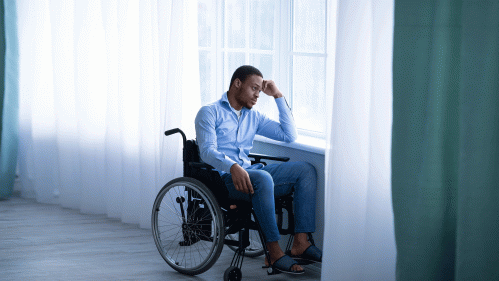Perceptions of Manhood and Masculinities Among Disabled Violently Injured Black Men in a Hospital-Based Violence Intervention Program

A Rutgers Health study finds participants’ disabilities also impacted their perceptions of independence
Black men with firearm-acquired disabilities face negative physical and psychological impacts on their manhood, independence and mobility, according to a Rutgers Health study.
The study, published in the American Journal of Men’s Health, explored the relationship between Black manhood/masculinities and firearm-acquired disabilities. Participants’ disabilities also impacted their perceptions of independence. Specifically, participants felt that they were a burden to their caretakers because of their reliance on them. This loss of independence took a serious toll on some participants in the study.
“Manhood is complex,” said Nazsa Baker, a postdoctoral fellow at the New Jersey Gun Violence Research at the Rutgers School of Public Health and lead author of the study. “In describing some optimal characteristics of what it means to be a man, disabled violently injured Black men discussed the importance of being a protector, provider, responsible, independent and having self-awareness. Most of the men described hegemonic ideals of manhood and how their definitions of manhood would impact others.”
Firearm violence is the leading cause of death among non-Hispanic Black males between the ages of 15 and 34. Managing life post-injury presents challenges with activities of daily living, including bathing, getting dressed and maintaining employment. Surviving firearm injuries has not only physical effects but also psychological impacts on one’s identity. Research has suggested that masculinity ideals among men with disabilities are likely to be renegotiated depending on specific factors, such as personal resources and societal expectations. While research has shed light on how some Black men cope with their disabilities, none have experienced a firearm-acquired disability.
Using a qualitative descriptive approach, the researchers interviewed 10 Black firearm violence survivors with disabilities. Recruitment was conducted through a hospital-based violence intervention program at a level I trauma center in New Jersey. Learning to live with a firearm-acquired disability is a significant transition for Black men, particularly for their perceptions of personal manhood.
One participant said, “You know, physically, it is hard to walk with a cane or roll around in my wheelchair. I cannot just get up and walk to the store. I got to ask my wife if she wants to go, or I have to pull out my chair and roll to the store.”
The researchers said if services and policies aimed at supporting Black men with firearm-acquired disabilities are to be impactful, scientists and practitioners must understand what shapes Black men’s ability to adapt and overcome personal and societal stigma related to idealized masculinity in the context of the disability.
Future research should address the limitations of this study, the researchers added. First, future studies should recruit Black men with firearm-acquired disabilities from various hospitals throughout the U.S. rather than from one hospital in New Jersey. Second, qualitative interviews should be conducted in person rather than remotely for researchers to gain greater rapport and trust with participants.


